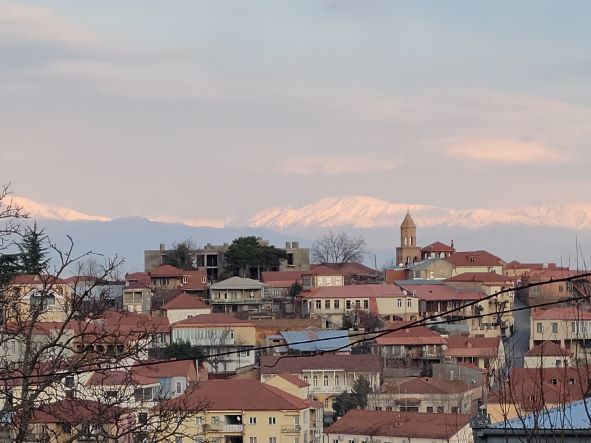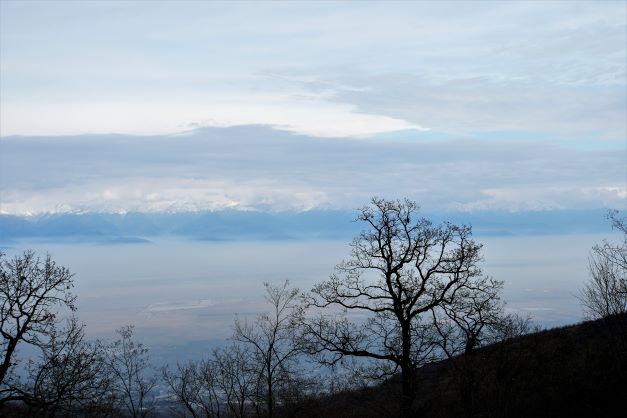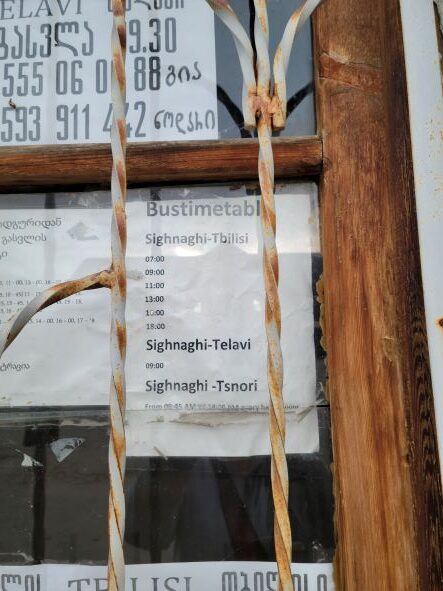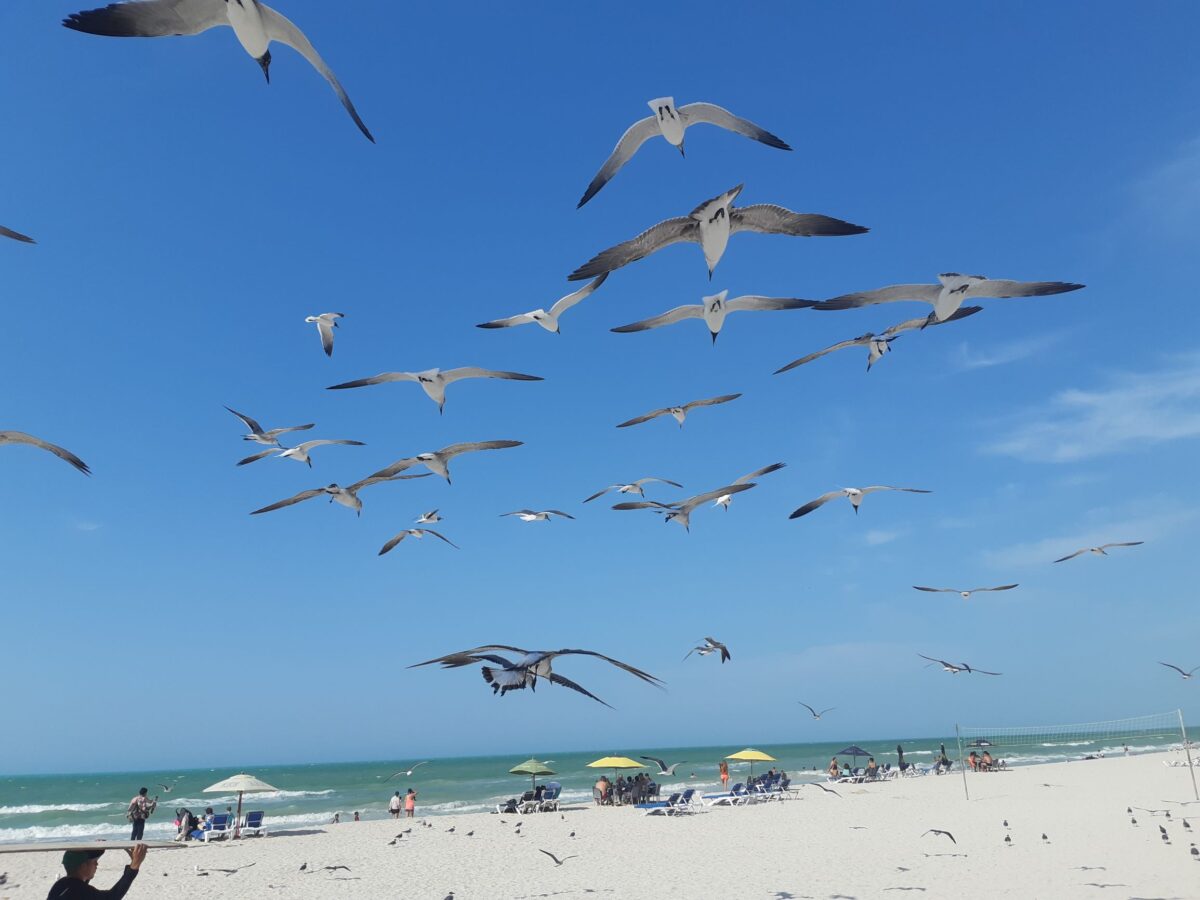Signagi (also spelled Sighnaghi) is a beautiful town in the Georgian wine region of Kakheti. We decided to visit this much-talked-about town after being in Tbilisi for just two weeks. Signagi is sometimes called “the City of Love” and is a two-hour Marshrutka (van) ride from Tbilisi. Thinking that this would be a nice change of scenery, if only for a few days. Continuing to read, you will find our Visitors Guide, Signagi Amazing Things to See And Do.

Signagi serves as a popular tourist destination due to its location in the heart of Georgia’s wine-growing region. Additionally, the towns surrounding scenic landscapes and pastel-colored buildings, complete with narrow cobblestone streets, make a lovely backdrop for just about anything. Signagi is perched on a steep hill overlooking the Alazani Valley, with the beautiful Caucasus Mountains far in the distance.

Visitors Guide Signagi
Visitors guide, Signagi is in the eastern region of Kakheti. One can use a town as a base to see some local sights and experience some wine tasting at the many wineries throughout the area. You can visit as a day trip, but we recommend two nights as this gives you a more relaxed visit. Plus, the opportunity to enjoy some of the many restaurants serving excellent locally sourced Georgian food and wines.



How To Get to Signagi From Tbilisi
Getting to Signagi is relatively easy; most people visit from Tbilisi. Either by day trip tour, hired driver, or, as we did, using the marshrutka bus system. Walking in the old town area, you will find many people selling tours or drivers that you can hire, depending on your budget and comfort level.
To catch the Marshrutka bus, you will need to find your way to Samgori Railway Station. There are many ways to achieve this, Bolt car service, a taxi, or a city bus. We recommend using the Bolt car service (same as uber but no uber in Georgia). I believe the Marshrutka bus service starts at 9 am to Signagi and runs every two hours until 1700. The Marshrutka is very affordable at 8 lari per person one-way and a 1 1/2 – 2 hour trip, depending on misc factors.
We found the Marshrutka comfortable enough, but this depends on your definition of comfort. Also, driving in Georgia may not be what you are used to. At times you need to close your eyes and put your faith in the drivers’ abilities or St Nino.

What To See And Do In See In Visitors Guide Signagi
- Bodbe’s St. Nino’s Convent is a must-see, just 3kms from Signagi, a very doable walk
- Visit the Wall, which encases parts of Signagi, built in the 1750s
- Walk the beautiful cobblestone streets of Signagi and explore its mysteries
- Zipline from a roadside pull-out all the way into downtown (for the adventurist)
- Visit the local winery Pheasant’s Tears Winery, there was another Cradle of Wine Marani, but it appeared to be closed at the time we visited.
- Hire a guide/driver (Guest House Eka & Gio) and tour other wineries in the area, we visited Kvareli Wine Cave and Duruji Valley.
Bodbe’s St. Nino’s Convent
The St. George’s Monastery of St. Nino, sometimes called the Bodbe Monastery, is one of Georgia’s most important religious sites. According to legend, St. Nino died at 60 in Bodbe in 335 CE. After having witnessed the conversion of Georgians to the Christian faith. She crossed the entire country during her lifetime, healing people and preaching Christianity. St. Nino has been credited with bringing Christianity to Georgia. She asked to be buried in Georgia, where she had spent her life. At the direction of King Mirian III, a small monastery was built at the place where Nino was buried. In 850, the newer Cathedral that stands today was built on the spot of the older temple.



The religious complex at Bodbe has been repeatedly repaired and restored. In the 16th through 17th centuries, Bodbe was an important educational center. But in 1837, the monastery was closed, then opened again in 1889 under the support of Alexander III. Again closed in 1924 under the Soviet Union, when it was used as a hospital. Additionally, in 1991, Bodbe opened as a convent for nuns.



Visiting St. Nino’s Convent is about a 3km walk from Signagi, with beautiful views. There is a spot along the road where you can take a zipline back into the center of town. We met another local vendor selling homemade wines and other products such as dried fruit, walnuts, and salsa, all very tasty. Always a good idea to support locals when you can.




Walking up to St. Nino’s convent, you can see the convent on the left. To the right is the bell tower hidden behind branches and a gate that leads onto the grounds, with no entrance fee. Just outside the grounds, there are washrooms and an area you can purchase something to eat if I remember correctly. The grounds and buildings themselves are magnificent, a very tranquil spot. The view eastward toward the Caucasus Mountains in the distance is gorgeous. The experience of visiting this church and convent is unforgettable, a must if you are in the area. If time and weather permit, you can venture down to the holy spring as these waters are said to have healing powers.



Signagi City Wall
Sighnaghi Fortress was built in 1762 by King Erekle. It occupies an area of over 40 hectares. The length of the fence is nearly 5 kilometers, with 23 towers and six arched gates. The Towers bore the names according to the villages that helped build and defend them. During the enemy invasion, the whole population of the fortress-building villages took refuge within the walls. Sighnaghi fortress-wall was built of cobblestones and is two-tiered. The wall thickness of the lower tier is 1.5 meters, the thickness of the upper level is 70-80 cm.
Today the wall is almost restored to its original form, and visitors can climb the two-story walls and look at the glorious Alazani Valley from the arches.



Seeing the walls and towers are awesome, an amazing feat considering the terrain it was built on. There is a section in Signagi where you can walk the wall and explore inside one of the towers, a fascinating experience.



Visitors Guide Signagi Taking A Walk Tour
Visitors guide to Signadi, walking is the best way to see and experience this quaint small town. After arriving in Signagi, we were able to drop off our bag at our homestay. With our bags taken care of, it was off to explore our new surroundings. First on the list was St. Nino’s Convent, a 3-kilometer walk along the road that we just came in on. The walk was comfortable enough, and the weather cooperated. Views along the way were amazing, especially with the Caucasus Mountains in the background.




After visiting St. Nino’s, it was off in an easterly direction, the other side of town to find St Georges’s Church. Try as we may, we had no luck in this endeavor, so it was back to town. Similarly, the views were just as beautiful, with mountains and the Alazani Valley. While walking along the roadway, we were able to see the wall as it crossed a small valley. We crossed under its archways and walked past several of the towers in several locations.



Once back into town, we ventured down another road that took us to Signagi St. George basilica. Down this way, you will have an opportunity to walk upon the wall and explore one of the towers found in that section of the wall. A great location to wander and enjoy the sights of days gone by. You will also find several restaurants in the area to replenish your body with tasty Georgian food and wines.


All in all, Signagi is a very walkable town with cobblestone streets. So if you are up to a walk, we recommend exploring Signagi using your feet. You will find a mix of buildings from very old to just dated and slowly crumbling.
Kvareli Wine Cave
This unique wine cellar and tourist complex is built on the edge of Alazani Valley. A place that attracts Georgian and foreign tourists alike. The cave, carved into the Caucasus rock, was opened in 1962 specifically for the World Congress of Vine and Wine. Throughout the year, the cave temperature ranges between 12-16 ° C. This creates an ideal environment for wine storage and aging. The wine bottles in the cave are positioned horizontally to ensure that the cork is constantly wet during the aging period.




The total length of the Wine Tunnel is 7.7 km, which consists of two main and 13 connecting tunnels. One of the entrances to the cave is used for tourism. The other entrance is used for the care and aging of wines stored in metal and oak containers. The guest can see where up to 26,000 bottles of high-quality wine are stored in this tunnel. The oldest collectible wine is 17 years old.
There are different tour packages that you can purchase when you visit the Wine Cave. From the standard package up to a Premium package, all with varying forms of involvement. We visited the cave itself and tasted several wines accompanied by Georgian cheese and bread. While tasting the wines, it was explained to us the differences in the wines, and she also explained the different processes that the wines went through. As this was the off-season, we were the only people touring and tasting in the cave. Kind of nice as the experience was more one-on-one.
Duruji Valley Wines
Our second wine tour stop was Duruji Valley Wines. We needed to wait for a tour guide that could speak English. Duruji Valley winery is located in the village of Kvarell in the wine-growing region of Kakheti, open from 9-7. Once our tour guide arrived, a young woman, we were taken around the winery. After talking to our guide we found out this was her first job, and she informed us that she enjoyed the work. Saying she got to meet many people from different countries, with that an opportunity to learn different languages at the same time


We found the tour to be interesting and informative; this winery dates back to the 16th century. Duruji winery uses the old techniques of winemaking, the Qvevri, and modern techniques used worldwide. We visited several rooms and then stopped in the room with a dozen or so sealed Qvevri’s buried in the floor. Each Qvevri is 3 meters tall, I can’t remember how many liters each one held, but it was a large number.



Next, we were off to a storage area where this winery stores wines for individuals, countries, or whomever as long as you have the monies for this service (one can only wish). We then visited the underground cellars full of wine barrels laying there aging. All-in-all a very interesting tour, next, it was off to taste some of these incredible wines. We tried 4 different wines two that were dry and made using the Qvevri method and two that were semi-sweet. Wines made using the Qvevri method are always dry as no chemicals or sweeteners are used, it is an all-natural process. They say it is always a surprise as to how the wines will taste using the Qvevri method because there is no interaction, just mother nature at work. The tasting costs 8 lari, a small price to pay for some excellent wine tasting. We ended up purchasing several bottles of white semi-sweet wines. If you are going to stop, allow yourself 2-3 hours to visit this winery.
Visitors Guide Signagi Foods
While in Signagi, we had several meals at local restaurants and thoroughly enjoyed the flavors. We found the flavors more intense than some of the meals we tried in Tbilisi. There are many restaurants to choose from all along the main street. You need to choose what you are looking for and the budget you have in mind.





Covid-19 Protocols
Here are some of the Covid-19 protocols that we have run across during our stay in Sagnagi and, for that matter in the rest of Georgia as well. You need to prove that you have been double vaccinated, and the last shot needs to be 14 days or longer from the current date. This proof will be requested when flying and entering some stores, restaurants, and Museums. Georgia has a passport system that the locals can use, but we tried to get this QR passport but failed. Long story short if you can prove with documentation and a piece of picture ID your good.
The requirement to wear masks when entering any building, purchasing tickets at a wicket, entering restaurants, and in crowded locations.
Our Thoughts On Visitors Guide Signagi Amazing Things To See And Do
We enjoyed our short visit to Signagi, it is always nice to get out into the country and see different aspects of life rather than just the city. There are enough things to see and do in Signagi to make this a worthwhile destination. We found food and lodging costs lower here and a little more laid-back atmosphere. So if you are looking for a destination in Georgia, please consider Signagi I don’t think that you will regret it.
Posts Related To Our Travels In Georgia
Tbilisi is the capital of Georgia, where we started our Georgian adventures. We fell in love with the city and ended up staying here for six weeks here. A large post with lots of good information.
Gori is the first down we visited after leaving Tbilisi in our travels toward Batumi and onward to Turkey have a read, and I hope you enjoy it.
Akhaltsikhe, we have four days booked where we intend to visit these unique sights. Akhaltsikhe has a vast and impressive Fortress situated atop a hill. In addition, you can visit the Resort Town of Abastumani, which is a short drive away. Here you can soak your weary bones in sulfur bath pools as the Russian nobles did many years ago. If you are looking for something completely different, then visit the Cave Monastery of Vardzia. Known as the home of Queen Tamar.
Why Visit Kutaisi, What Makes Kutaisi Interesting you can find many historical icons from Monasteries to Fortresses. Extraordinary underground caves such as Prometheus Cave and Sataplia, where you can see dinosaur footprints and explore Karst cave. Good Georgian food is plenty, plus you can visit the fascinating Green Baazar.
Batumi is a seaside Georgian City located on the black sea just 12 kilometers north of the Turkish Georgian border. Cindy and I are happy to be here, the last stop of our Georgian travels, and we are excited to Experience Batumi and Discover What Makes It Special. We have set aside two weeks to explore Batumi.
Support Our Blog And Its Unique Travel Content
You can support our site by using the links through our travel Essential. We will receive a small commission if you purchase items using our links. There are no extra or hidden costs to you. These commissions assist us in our travel, so we can provide unique content to you through each blog post. If you enjoy our blog and find it interesting and informative, please share it with friends. Subscriber, so you never miss a new post. Thank you.
Recommended Travel Essential
Cindy and I call ourselves nomadic. With this lifestyle, we use certain essentials to make this way of life easier and more comfortable. With this in mind, we have composed a list of what we feel is essential. Some tips you might use to plan or take your next travel adventure.
- Travel Packing Essentials to help organize and make this task less stressful.
- Travel Safety Essentials to make your life on the road a little safer, giving you peace of mind
- Living essentials to make life a little more comfortable, be this resting, working, or playing.
Accommodation Options While Traveling The World
- Booking.com is one of our go to’s when we are looking for a place to stay for a couple of days or longer.
- Agoda.com, we find is best to use when in Southeast Asia, but hey, you never know what you might find
- Airbnb.com used to be our go-to, but some of their cancelation policies are reasonable, give them a try as well.
Travel Insurance
We always travel with some travel Insurance, be it just medical or complete trip coverage. Remember, don’t travel without coverage, the savings are not worth the possible costs.
Some links on this page are affiliate links, meaning we may earn a commission if you buy a product using our link. This commission comes at no additional cost to you. Disclaimer.








